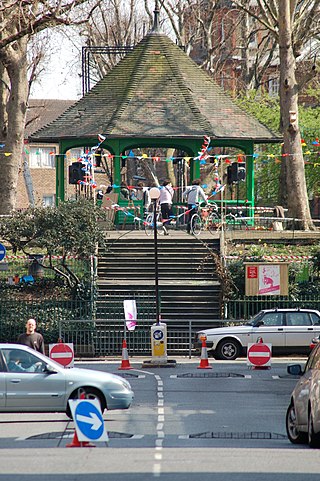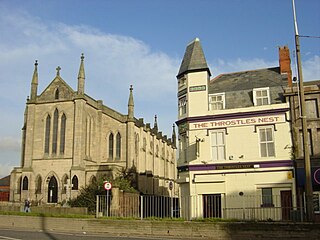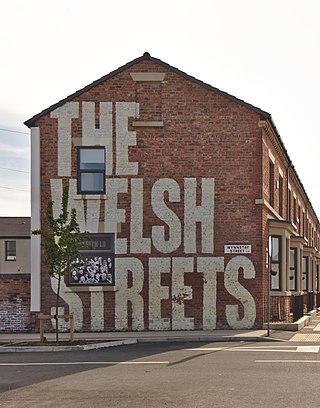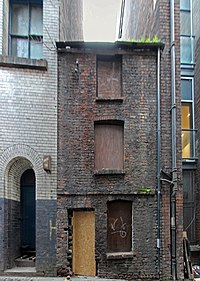
Toxteth is an inner-city area of Liverpool in the county of Merseyside.

Canning Town is a district in the London Borough of Newham, East London. The district is located to the north of the Royal Victoria Dock, and has been described as the "Child of the Victoria Docks" as the timing and nature of its urbanisation was largely due to the creation of the dock. The area was part of the ancient parish of West Ham, in the hundred of Becontree, and part of the historic county of Essex. It forms part of the London E16 postcode district.

A tenement is a type of building shared by multiple dwellings, typically with flats or apartments on each floor and with shared entrance stairway access. They are common on the British Isles, particularly in Scotland. In the medieval Old Town, in Edinburgh, tenements were developed with each apartment treated as a separate house, built on top of each other. Over hundreds of years, custom grew to become law concerning maintenance and repairs, as first formally discussed in Stair's 1681 writings on Scots property law. In Scotland, these are now governed by the Tenements Act, which replaced the old Law of the Tenement and created a new system of common ownership and procedures concerning repairs and maintenance of tenements. Tenements with one or two room flats provided popular rented accommodation for workers, but in some inner-city areas, overcrowding and maintenance problems led to shanty towns, which have been cleared and redeveloped. In more affluent areas, tenement flats form spacious privately owned houses, some with up to six bedrooms, which continue to be desirable properties.

The Birmingham Back to Backs are the city's last surviving court of back-to-back houses. They are preserved as examples of the thousands of similar houses that were built around shared courtyards, for the rapidly increasing population of Britain's expanding industrial towns. They are a very particular sort of British terraced housing. This sort of housing was deemed unsatisfactory, and the passage of the Public Health Act 1875 meant that no more were built; instead byelaw terraced houses took their place. This court, at 50–54 Inge Street and 55–63 Hurst Street, is now operated as a historic house museum by the National Trust.

Back-to-backs are a form of terraced houses in the United Kingdom, built from the late 18th century through to the early 20th century in various forms. Many thousands of these dwellings were built during the Industrial Revolution for the rapidly increasing population of expanding factory towns. Back-to-backs share party walls on two or three of their four sides, with the front wall having the only door and windows.

Multifamily residential, also known as multidwelling unit (MDU)) is a classification of housing where multiple separate housing units for residential inhabitants are contained within one building or several buildings within one complex. Units can be next to each other (side-by-side units), or stacked on top of each other (top and bottom units). Common forms include apartment building and condominium, where typically the units are owned individually rather than leased from a single building owner. Many intentional communities incorporate multifamily residences, such as in cohousing projects.

The Boundary Estate is a housing development in the London Borough of Tower Hamlets, in the East End of London.

Vauxhall is an inner city district of Liverpool, England, north of the city centre, bounded by Kirkdale to the north and Everton to the east, with the docks and River Mersey running along the west side.

Everton Park, located in Everton, Liverpool, England, is a modern park, covering over 40 hectares (0.40 km2), created between 1984 and 1989, as part of a major house clearance programme, on Everton Hill between Great Homer Street and Everton Road/Heyworth Street. The park is Liverpool City Council owned.

Glasgow, the largest city in Scotland, has several distinct styles of residential buildings. Building styles reflect historical trends, such as rapid population growth in the 18th and 19th centuries, deindustrialisation and growing poverty in the late 20th century, and civic rebound in the 21st century.
The 1950s and 1960s saw the construction of numerous brutalist apartment blocks in Sheffield, England. The Sheffield City Council had been clearing inner-city residential slums since the early 1900s. Prior to the 1950s these slums were replaced with low-rise council housing, mostly constructed in new estates on the edge of the city. By the mid-1950s the establishment of a green belt had led to a shortage of available land on the edges of the city, whilst the government increased subsidies for the construction of high-rise apartment towers on former slum land, so the council began to construct high-rise inner city estates, adopting modernist designs and industrialised construction techniques, culminating in the construction of the award-winning Gleadless Valley and Park Hill estates.
The District of Columbia Alley Dwelling Act established the National Capital Housing Authority (NCHA) as “The Authority” on June 12, 1934. Executive Order 6868 renamed the agency as the Alley Dwelling Authority, designated its membership, and outlined its functions. Originally, the Authority confined its activities to slum reclamation in squares in the District containing inhabited alleys. At the time the Authority began its operations there were approximately 200 such squares. Under the Act, the Authority could redevelop an alley square for any purpose that served the interest of the city. As many of these squares were not adapted to low-rent housing, the Authority sought amendments that would enable it to build dwellings for low-income families equal in number to those displaced by its slum reclamation on other sites. In the meantime, the United States Housing Act of 1937 was passed. At the next session of Congress, the Authority secured the desired amendments to its act and was authorized to borrow from the United States Housing Authority on the same terms as local housing authorities in other cities.

Homer Street is a quiet one-way street in the Marylebone neighbourhood of the City of Westminster, London. It runs from Old Marylebone Road in the north to Crawford Street in the south. The street is part of the Marylebone Ward of Westminster City Council. Its postcode is W1H.

A byelaw terraced house is a type of dwelling built to comply with the Public Health Act 1875. It is a type of British terraced house at the opposite end of the social scale from the aristocratic townhouse but a marked improvement on the pre-regulation house built as cheap accommodation for the urban poor of the Industrial Revolution. The term usually refers to houses built between 1875 and 1918.

Public housing in the United Kingdom, also known as council housing or social housing, provided the majority of rented accommodation until 2011 when the number of households in private rental housing surpassed the number in social housing. Dwellings built for public or social housing use are built by or for local authorities and known as council houses. Since the 1980s non-profit housing associations became more important and subsequently the term "social housing" became widely used, as technically council housing only refers to housing owned by a local authority, though the terms are largely used interchangeably.

Terraced houses have been popular in the United Kingdom, particularly England and Wales, since the 17th century. They were originally built as desirable properties, such as the townhouses for the nobility around Regent's Park in central London, and the Georgian architecture that defines the World Heritage Site of Bath.
A pre-regulation terraced house is a type of dwelling constructed before Public Health Act 1875. It is a type of British terraced house at the opposite end of the social scale from the aristocratic townhouse, built as cheap accommodation for the urban poor of the Industrial Revolution. The term usually refers to houses built in the century before the 1875 Act, which imposed a duty on local authorities to regulate housing by the use of byelaws. Subsequently, all byelaw terraced housing was required to meet minimum standards of build quality, ventilation, sanitation and population density. Almost all pre-regulation terraced housing has been demolished through successive waves of slum clearance.

The Welsh Streets are a group of late 19th century Victorian terraced streets in Toxteth, Liverpool, England. The houses were designed by Welsh architect Richard Owens and built by Welsh workers to house workers mainly involved in the industries on the docks; the streets were named after Welsh villages and landmarks. The Beatles drummer Ringo Starr lived the first few years of his life in Madryn Street. Although some original houses were lost in World War II bombing, many of the terraced properties in the original street configuration remain in the present day.

The Granby Four Streets is an area in Toxteth, Liverpool, England, comprising four streets at the tip of a triangle near the Grade II* listed Princes Park. The streets, designed by Welsh architect Richard Owens and built by Welsh workers during the late 19th century are Beaconsfield Street, Cairns Street, Jermyn Street and Ducie Street. A fifth street, Granby Street, connects the four streets together and mostly contains commercial units.

Slum clearance in the United Kingdom has been used as an urban renewal strategy to transform low-income settlements with poor reputation into another type of development or housing. Early mass clearances took place in the country's northern cities. Starting from 1930, councils were expected to prepare plans to clear slum dwellings, although progress stalled upon the onset of World War II.


















